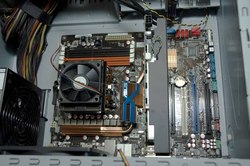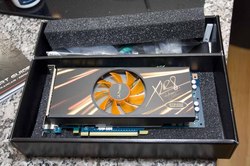Like so many of us, as he upgraded his PC, my friend John¹ didn’t know what to do with the old one. He had a relative, a grown man, with no computer, and John asked if I’d set him up with this old one.
This is something I’ve done dozens of times, and I almost always reinstall Windows. This time, I thought I’d try something a little different.
The end user wasn’t going to play games or work in multimedia. He was going to use the computer for web surfing and email. Instead of Windows, I installed Ubuntu Linux.
My thought is, this guy doesn’t know anything technical. Why saddle him with an operating system that’s got a bullseye on it, attractive to anyone writing spyware or viruses?
The install went flawlessly. I inserted the Ubuntu disk, answered a few questions (actually, John did all of this) and let the PC do its thing. The only bumps in the road had to do with installing Flash (I wish Ubuntu came with this already installed) and attempting to upgrade the video driver.
I rebooted after updating the driver and ended up with a blank screen! Damn you penguin. As has happened so often in the past, I had fixed the computer to the point of breaking it!
The bad video driver was quickly removed. John watched as I typed some cryptic commands into a text based terminal screen. One bad part of Ubuntu (and all Linux distributions) is, most people would be lost at this point with a dead PC! There are fewer ‘Geoff’s’ to call for technical assistance with this esoteric operating system.
John was pretty pleased (and hopefully his relative will be pleased too). The old computer is quite agile and more than beefy enough for its new assignment.
Refurbishing this computer was the purpose of his trip, but John brought more goodies with him. His wife’s company had thrown out some older laptops… which she then rescued from the trash. I could have one, but there was a problem. It was unusable!
The laptop, a very sweet Fujitsu Lifebook Series B subnotebook (a tiny laptop, perfect for traveling) had Windows 2000 installed and was password protected. The password kept me from getting to the programs and the lack of a CD drive kept me from installing a new operating system (like Linux) as a replacement.
In situations like this, I become obsessed.
The Fujitsu has only a USB external floppy drive. It was a comedy of errors as I realized none of my current home machines had floppies, plus I had no floppy disks. There was lots of ad libbing and part swapping to be done.
I scrounged the hardware, then headed to the net, trying to find a solution. Amazingly enough, there are simple single floppy programs which will read and then allow you to overwrite a password. I didn’t have to crack the code. I just inserted my password where the original had been.
I felt like a spy as the computer was now programmed to consider me the administrator.
This was great for me, but you have to worry about the level of protection built into today’s modern computers. In essence, Microsoft led the original owners to believe these laptops were under electronic lock and key. A guy in his pajamas sitting on the floor shouldn’t be able to crack open this laptop… but I did.
Before I went to bed, the laptop downloaded a few years worth of patches from the Microsoft site and was fitted with a wireless card.
This morning, I brought the machine downstairs and played with it a little while eating my breakfast. I was proud of my accomplishment.
“Why do you need another computer,” Helaine asked?
It’s an obsession I suppose. Some folks go nuts over shoes or jewelry or cars. For me, it’s wire and computers. Neither should ever be thrown out – ever.
¹ – John’s friends call him “Big John.” He is a massive man, well over six feet tall. John’s heart is proportional to his height.
 As mentioned earlier my major birthday gift was a new computer. I wanted something beefy and speedy. That meant no store bought PC, but something assembled here at home–literally on the kitchen table!
As mentioned earlier my major birthday gift was a new computer. I wanted something beefy and speedy. That meant no store bought PC, but something assembled here at home–literally on the kitchen table! This is my first time with the new generation of powerful video cards. My card is quite imposing! It’s probably as powerful on its own as my last fully assembled PC.
This is my first time with the new generation of powerful video cards. My card is quite imposing! It’s probably as powerful on its own as my last fully assembled PC.
 The Linux mascot is Tux the Penguin. He’s become a joke in the Fox Family, with Helaine often reminding me how the penguin and I don’t get along.
The Linux mascot is Tux the Penguin. He’s become a joke in the Fox Family, with Helaine often reminding me how the penguin and I don’t get along.